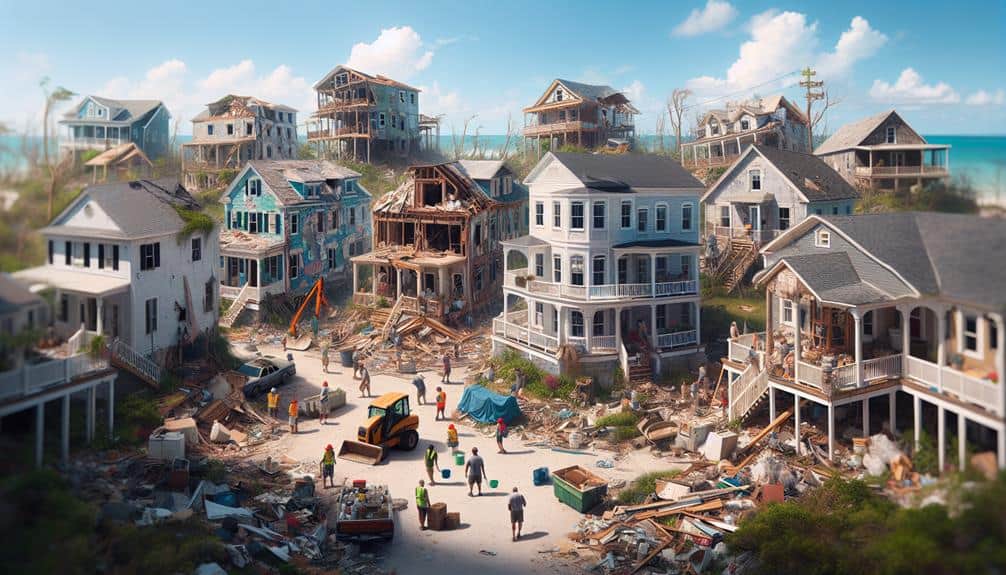Hurricanes hit coastal communities hard, causing severe economic damage, infrastructure destruction, and human displacement. We see businesses shutter, leading to lost jobs and financial instability. Roads, bridges, and utilities get demolished, hampering emergency response and slowing reconstruction. Evacuations strain resources, while health concerns spike due to water contamination and injuries. Ecosystems face devastation, with coastal erosion hurting habitats and marine life. Social networks fragment as displacement disrupts communities, exacerbating psychological distress. Long-term recovery is a complex, resource-intensive process that requires careful planning and targeted aid to restore stability and resilience. Explore further to grasp the full scope of these impacts.
Key Points
- Hurricanes cause significant economic damage, including business closures, job losses, and disrupted livelihoods.
- Infrastructure like roads, bridges, and utilities are devastated, hindering emergency response and long-term recovery.
- Human displacement is common, with both immediate evacuations and long-term relocations affecting socioeconomic stability.
- Health concerns arise from injuries, water contamination, and mental health challenges, exacerbated by disrupted healthcare services.
Economic Damage
The economic damage inflicted by hurricanes on coastal communities is both immediate and long-lasting, affecting infrastructure, businesses, and local economies. In the immediate aftermath, business closures are rampant. Many establishments, from small local shops to larger enterprises, face significant disruptions, resulting in lost revenue and unemployment. These closures don't just halt economic activity; they erode the community's financial stability and resilience.
Financial assistance plays an important role in mitigating these impacts. Government aid, insurance payouts, and emergency loans provide immediate relief and support recovery. However, the effectiveness of this assistance varies. Bureaucratic delays and insufficient funding can hamper the speed and adequacy of aid distribution, leaving many businesses struggling to reopen. Additionally, the reliance on external financial assistance highlights the vulnerability of coastal economies to natural disasters.
As we navigate these challenges, it's crucial to understand that the economic damage extends beyond the initial impact. Prolonged business closures can lead to a decline in local economic activity, reduced tax revenues, and a slower overall recovery.
Infrastructure Destruction
Hurricanes wreak havoc on coastal communities by devastating infrastructure, including roads, bridges, and utility systems, which are essential for daily operations and emergency response. When these crucial components are compromised, the immediate aftermath is chaos.
Roads become impassable, hindering the movement of emergency vehicles and supplies. Bridges, often the only routes across waterways, can be severely damaged or completely destroyed, isolating entire neighborhoods.
Utility systems, such as electricity, water, and communication networks, are particularly susceptible. Downed power lines can result in extended blackouts, delaying reconstruction efforts and complicating rescue missions. Water treatment facilities often face contamination or mechanical failure, jeopardizing public health. Communication breakdowns impede coordination among first responders and leave residents without important updates.
Reconstruction efforts in the wake of such destruction require meticulous planning and significant resources. We must prioritize restoring critical infrastructure to re-establish normalcy and support emergency response activities. Collaborating with federal, state, and local agencies, along with private sectors, accelerates the rebuilding process.
However, the sheer scale of damage often means that full recovery can take years. By investing in resilient infrastructure, we can mitigate future risks and enhance our readiness for subsequent hurricanes.
Human Displacement
When hurricanes strike, we often face immediate evacuation orders that compel us to seek temporary shelter, sometimes for extended periods.
The impact doesn't stop there; many of us are compelled to contemplate long-term relocation due to the extensive damage to homes and infrastructure.
These disruptions not only affect our physical safety but also have profound implications on our socioeconomic stability.
Evacuation and Sheltering
Evacuation protocols demand detailed planning to guarantee the safe and efficient relocation of coastal communities in the path of an impending hurricane. As we navigate the complexities of emergency response, it's essential to build community resilience to handle such crises effectively.
Our evacuation strategies hinge on several core elements:
- Coordination among agencies: Ensuring seamless communication between local, state, and federal agencies enhances the efficiency of evacuation procedures.
- Public awareness campaigns: Educating residents on evacuation routes and shelter locations bolsters their readiness and reduces chaos.
We mustn't underestimate the importance of well-organized sheltering operations. Shelters should be equipped to provide not only physical safety but also essential services like medical care and mental health support. The deployment of these shelters needs to be swift and strategically located to minimize travel distances for evacuees.
In analyzing our emergency response mechanisms, we must aim for precision and adaptability. Our goal is to empower communities with the knowledge and resources they need to withstand and recover from the disruptive force of hurricanes. By fostering a robust framework for evacuation and sheltering, we enhance our collective resilience and uphold our community's autonomy.
Long-term Relocation
Long-term movement, a critical aspect of human displacement, demands careful planning and robust support systems to ensure displaced individuals can rebuild their lives in new environments. We must address the complex challenges associated with uprooting entire communities. A primary consideration is ensuring access to housing, which requires coordination between public and private sectors. We need to consider the availability of jobs, healthcare, education, and transportation to sustain community resilience.
Disaster preparedness plays a pivotal role in mitigating the extent of long-term movement. By investing in infrastructure that can withstand hurricanes and developing detailed evacuation plans, we can reduce the number of individuals forced to permanently leave their homes. However, when movement is unavoidable, providing mental health support to cope with the trauma of displacement and the loss of familiar surroundings is crucial.
Community resilience is further strengthened when displaced persons are actively involved in the decision-making processes concerning their new environments. By fostering a sense of agency and belonging, we can facilitate smoother changes and enhance overall well-being.
Therefore, long-term movement isn't just about relocating people; it's about empowering them to thrive in new settings while maintaining a strong sense of community.
Environmental Impact
Hurricanes often devastate coastal ecosystems, leaving behind eroded coastlines, saltwater intrusion, and disrupted habitats. These powerful storms can greatly alter marine ecosystems and contribute to coastal erosion, which has wide-ranging consequences for biodiversity and human activities.
Eroded Coastlines:
The intense wave action and storm surges strip away sand and sediment, reshaping shorelines and sometimes resulting in the loss of important habitats like marshes and dunes.
Saltwater Intrusion:
When seawater penetrates freshwater systems, it can lead to the death of plants and wildlife that aren't adapted to saline conditions, changing the ecological balance.
Disrupted Habitats:
Hurricanes can destroy coral reefs, seagrasses, and mangroves, which serve as essential nurseries for marine life and help protect coastlines from further erosion.
We must recognize that the immediate impact on marine ecosystems isn't just physical. The chemical balance of these environments also changes, affecting nutrient cycles and the health of aquatic species.
Coastal erosion exacerbates these issues by accelerating habitat loss, making it harder for ecosystems to recover.
As we continue to study these impacts, it's vital to develop adaptive strategies that mitigate damage and support the resilience of coastal communities and natural habitats alike.
Health Concerns

As we evaluate the environmental damage, we also need to address the significant health concerns that arise in the aftermath of hurricanes, impacting both immediate and long-term well-being of coastal communities. The physical toll from injuries during the storm and exposure to contaminated water and debris can't be overlooked. However, the psychological impact, including mental health issues such as anxiety, depression, and post-traumatic stress disorder (PTSD), is equally vital.
In the immediate aftermath, public safety becomes a priority as healthcare facilities often operate under strained conditions. We must make certain that emergency medical services are available to treat injuries and prevent the spread of waterborne and vector-borne diseases. Contaminated water supplies and disrupted waste management systems can lead to outbreaks of illnesses like cholera and dysentery.
Long-term, the stress of rebuilding lives and homes can exacerbate mental health issues. Community support systems, including counseling services and mental health resources, should be prioritized to help residents cope.
Social Disruption
The social fabric of coastal communities often faces significant disruption in the wake of hurricanes, undermining local economies, displacing residents, and straining essential services. When hurricanes strike, the immediate aftermath can be chaotic, leaving us grappling with various unprecedented challenges.
- Economic instability: Local businesses are often forced to close, leading to job losses and financial uncertainty.
- Displacement: Many residents are compelled to evacuate, sometimes permanently, which fragments social networks and communal ties.
Community resilience becomes a critical factor in navigating these upheavals. Strong social networks can help mitigate some of the disruption by providing emotional and logistical support.
However, the mental health impact can't be overstated. The trauma of losing homes, livelihoods, and sometimes loved ones, can lead to long-term psychological distress.
Collective efforts in mental health support and rebuilding social structures are crucial for fostering a sense of normalcy and stability.
Long-term Recovery

In evaluating long-term recovery, we must address the significant challenges in rebuilding infrastructure and accurately evaluating the economic impact.
These elements are critical in determining the sustainability and resilience of coastal communities.
Infrastructure Rebuilding Challenges
Managing the myriad complexities of infrastructure rebuilding after a hurricane demands meticulous planning and substantial financial investment. Our primary challenge lies in the efficient allocation of funding to bolster community resilience. It's essential that we judiciously distribute resources to prioritize essential services such as water, electricity, and transportation. This strategic approach not only restores functionality but also fortifies our communities against future storms.
However, we must navigate significant hurdles, particularly construction delays. These delays often arise from supply chain disruptions, workforce shortages, and regulatory red tape. Government support plays a pivotal role in mitigating these issues, yet bureaucratic inefficiencies can impede progress. Streamlining permitting processes and expediting approvals are vital steps to accelerate rebuilding efforts.
To hook our audience with further insights, consider the following:
- Multi-year timelines: Rebuilding infrastructure isn't a quick fix; it often spans several years.
- Technological advancements: Leveraging modern construction technologies can enhance speed and durability.
Economic Impact Assessment
While analyzing infrastructure rebuilding challenges, we must also conduct a thorough economic impact appraisal to understand the long-term recovery needs of coastal communities. By evaluating the economic recovery process, we can pinpoint areas where financial stability is compromised and implement strategies to bolster community resilience.
We need to start by examining the business impact. Many local businesses face operational disruptions, loss of inventory, and a decreased customer base post-hurricane. This not only affects individual livelihoods but also the overall economic ecosystem of the area. A detailed analysis of these impacts helps us prioritize which sectors require immediate support to kickstart the local economy.
In addition, we must assess the financial stability of households. Hurricanes often lead to job losses, reduced income, and increased expenses for repairs and temporary accommodations. Understanding the extent of these economic pressures allows us to develop targeted aid programs to help families regain their footing.
Frequently Asked Questions
How Do Hurricanes Impact Local Wildlife and Their Habitats?
Hurricanes cause habitat destruction and species displacement, leading to significant biodiversity impacts. We must increase conservation efforts to mitigate these effects, ensuring wildlife resilience and the preservation of crucial ecosystems for the future.
What Measures Can Individuals Take to Prepare for a Hurricane?
We can prepare for a hurricane by gathering emergency supplies, including water and non-perishable food, and mapping out evacuation routes. Staying informed through reliable sources guarantees our safety and helps us maintain our freedom during emergencies.
How Do Hurricanes Influence Local Tourism Industries?
Understanding how hurricanes influence local tourism industries, we investigate the economic impact. Effective marketing strategies, robust recovery efforts, and community engagement are essential to restoring tourism, ensuring economic resilience, and maintaining our freedom to explore.
What Is the Role of Technology in Predicting Hurricanes?
We rely on advanced weather forecasting technology to predict hurricanes accurately. This enables precise emergency response planning, ensuring we're prepared to safeguard lives and property, giving communities the freedom to react swiftly and effectively.
How Do Hurricanes Affect Education Systems in Coastal Areas?
We see hurricanes cause school closures and infrastructure damage, juxtaposing academic performance declines with funding shortages. While students need stability for success, repeated disruptions challenge their freedom to learn and grow in coastal education systems.

